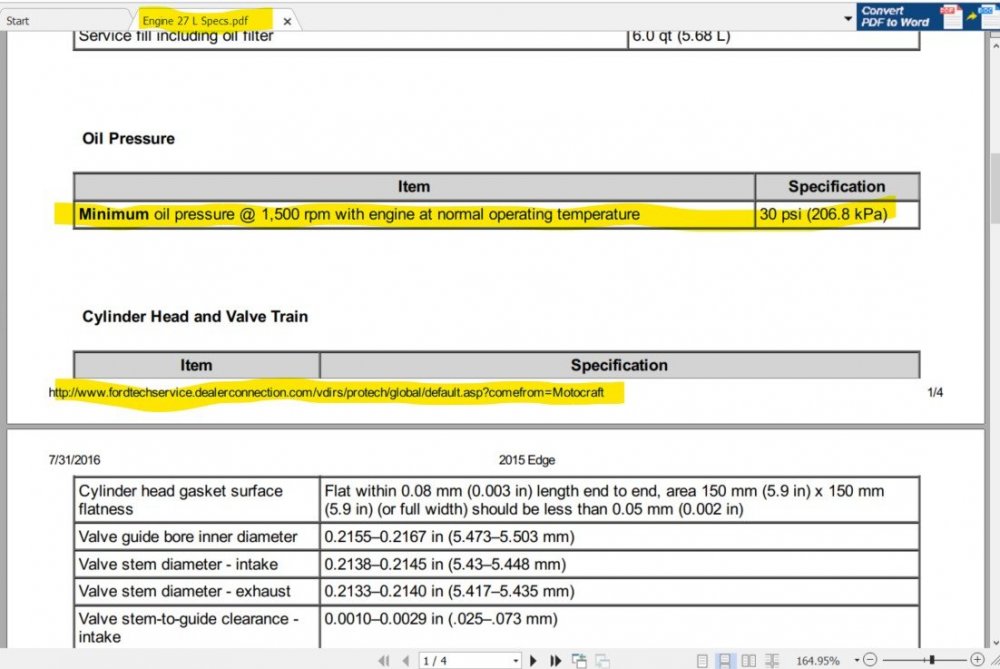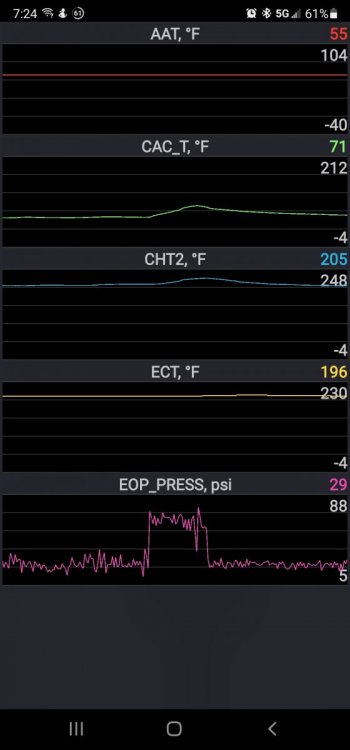-
Posts
436 -
Joined
-
Last visited
-
Days Won
35
Content Type
Profiles
Forums
Gallery
Everything posted by Cerberus
-
this is very interesting, thanks for that.
-
As far as a DTC, my transmission has a big slide in 3rd, like it sometimes never fully engages 3rd. The RPMs stay the same while road speed increases, until just before the 3>4 shift, then it catches the gear fully, RPMs and road speed climb together for a second or so, then goes to 4th. Now, there are ways the ECM PCM TCM (wtfe) could detect that and throw a code.. but it never does. Sliding clutches for an extended widow of time under load causes heat damaging the plates/bands and heating the fluid. This issue should set a code. But it does not. I'm sure their theory is, if it blows, hopefully it be outside of warranty when it does. They will not even fully acknowledge it officially when i brought it to the dealership for this concern. point being, there can be problems present that the coded out of setting a DTC by increasing the acceptable slippage detection rate. as far as the commercially available oil pressure gauge.. that's a fair point. we all know Ford's sensors are not particularly trustworthy historically. I do replace the filter holder stem / drain port seal with every oil change so I have no reason to suspect that as a cause. good input all around, thank you. (to all)
-
the source is a digital Ford Service Manual in PDF format. you notice below it is specifying valve stem & bore diameters
-
ok, I am not 100% sure but i was under the impression that the "oil control solenoid" ( a pretty nondescript name..) was in the next generation of the engine, not in mine.. Now i have to verify and research further.
-
All engine oil pumps have a pressure relief valve as far as I know.. I've never seen one that didn't. Our 2.7s have a variable displacement oil pump which only used for couple years, replaced with an electronically controlled unit shortly thereafter. That's one suspicion. Otherwise, being an off lease vehicle, it's possible that the person or corporation who leased it did not maintain it as someone who bought it might. Also, it was bounced off a guardrail by the prior 'owner' so who knows what might have happened then.. cracked oil pan, loss of oil, but driven home anyway..
-
From a large digital service manual type thing in multi pdf format, specific to the edge, with multiple variants included. And it's not 30psi at idle, it's 30psi at 1500 rpm at full temperature
-
Fair point, though the likelihood that the issue is related to an obstruction of the oil pump pick up is pretty minimal for two reasons. 1, the oil pan was just replaced under warranty due to leaks last summer, And 2, if the pickup were obstructed as you suggest, the oil pressure would probably not be higher when the oil is cold. And it definitely has more pressure cold. Honestly, I've never seen oil strainer fouling cause low oil pressure, though I have seen some fouled up strainers..
-
Since I am suffering from a low oil pressure condition, anything that brings oil pressure up to or moderately above minimum pressure spec should not be a problem. Also since the cam phaser controls work on a pulse width modulation to control how much oil flows into the phaser, thus controlling the cam timing, higher oil pressure is easily compensated by reducing the duty cycle of the timing control actuators, all the way down to zero if need be. Low oil pressure can cause a (seveal) big problem(s) but high oil pressure is less often a problem
-
I have Forscan and like to pull data from sensors, that in some cases I didn't even know existed.. like the "transfer case temperature sensor". Since the 2.7 has no oil cooler in the edge but it does in the F150, I started wondering about oil temperatures and oil pressure at normal operating temperature. Specs say that minimum oil pressure is 30psi @ 1500 rpm at temperature. Well the ambient temp hit 85 today so I checked my oil pressure when I got home from work and found it to below spec. Only about 25psi at 1500 rpm. Not horrible but not great. At idle, it dips into the lower teens. I've seen 12 or 13. So, I really want to install a coolant to oil cooler but it is not practical at this time. I also want to put in the cooler thermostat but have no place to do work due to lease restrictions where I live.. So I'm considering fattening up my viscosity by doing 3x 5w-30 and 3x 5w/10w-40 at my next oil change which I will do early just for the viscosity and oil pressure concern. Can anyone come up with any good reasons not to do this? Also of note, the warmest sensor while idle cooling when I got home was the so called transfer case fluid temperature was around 208.. higher than I would have expected for sure.
-
Incoming!
-
The fan kick in temp is really only relevant when high ambient temperature and/or low air speed collectively add up to reduce the heat removal capabilities of the radiator and intercooler. Regarding the intercooler, I have thought about installing a bank of nozzles to fog the charge cooler when full boogie is needed (like they did with the first stock GT3000 VR4 with nitrous fogging to get it over 200 mph) though I'd probably use washer fluid for cheap reasons But the truth is that I am not in need of more power than this thing makes on a good day, I just want to not lose power on hot days and maintain a long service life.
-
Yes, I know this is an old thread but it is a current subject of real interest for me since I've just moved to a warmer climate. I did a little Forscan data acquisition on the way to work today and found that with the original Thermostat the coolant temperature hangs between 196 and 199 once up to temp, while the cylinder heat temperature sensor normally hangs around 210, but jumped as high as 230 approximately when I was standing on the loud pedal and quickly dropped to normal when returning to cruise state.. throughout which time the coolant temperature only bumped about 1 degree. This tells us that the cooling system has plenty of heat dump available to keep CHT spikes in check. But, a cooler stat will, through an increased temperature differential, be better able to suck that heat out of the head and remain both safe (no detonation) and efficient (max timing available). If i were a betting man, I'd wager the PCM uses cylinder head temp (& knock sensors) to determine if the timing needs to he backed off for structural integrity purposes, and that value is best controlled by reducing coolant temperature, and a cooler stat helps with that.
-

Transmission sliding through 3rd on low throttle
Cerberus replied to Cerberus's topic in 2.7L EcoBoost
Sorry, i never saw this prior to now.. my notification emails don't work correctly on this site for some reason. Perhaps i've been placed in the miserable user category.. wouldn't be the first time Aaanyway, no, i never got anything even vaguely resembling any satisfaction on this problem, but, it never got worse either. I have changed the trans fluid (seeing as how its so easy with the drain plug and all) but that did not seem like it changed anything in performance or functionality. I plan on changing the trans fluid at every other oil change as long as I have the vehicle as a preventive measure. and since you traded your vehicle in you may never read this, but i don't like leaving communications unanswered -
no sir, its a 2016 Sport. i followed the link and changed the vehicle to 2016 edge sport and it said it does not fit that application
-
So, the 2.7 in the F150 application has an oil cooler installed on the rear head, passenger side. There is a block off plate on the head where it would be on my 2.7. Has anyone added an oil cooler? can it be done? Key consideration is space in that location for it to be installed. I like the idea of being able to dump some of the oil heat generated by the turbos etc, to the coolant, especially since i moved about 1000 miles south.. Has anyone done this? Thought about it?
-

Engine wants to stall - Code P1450 & P144A/C - Evap Purge Valve
Cerberus replied to shumax's topic in 2017-2018 Edge & MKX
Mine does this, only immediately after fueling.. I suspect it is a valve coking issue causing poorly balanced fueling that the computer compensates for, but it approaches a new tank of fuel as a variable (rightfully so) and so its confused for a little while. This is an educated guess, but based on one piece of evidence; On someone else's vehicle, After an induction clean up, it did not happen after fueling.. -

New Motorcraft oil filter FL-2062-A vs the FL-2062
Cerberus replied to 1004ron's topic in 2.7L EcoBoost
they did err on the lifetime fill idea of the PTU. .78qts of fluid, handling 3/4 of the total power output from the transaxle for the lifetime of the vehicle is ridiculous. glad that you can appreciate my intentions. if you do the reading you'll find that the 2087 if a direct replacement & upgrade for the 2062 in the gt500 application, and I can see no way that it would result in any less of an upgrade in whatever application it was placed into. but whateves. i'm done. -

New Motorcraft oil filter FL-2062-A vs the FL-2062
Cerberus replied to 1004ron's topic in 2.7L EcoBoost
True, but I'm sure you've heard of the 3.5L timing chain driven water pump failure causing oil contamination with coolant and subsequent engine failure, as actually did happen in my 2011 fusion sport. And yeah, I'm slamming Ford's engineering savvy of putting a water pump inside an engine, such that it water pump replacement requires drivetrain removal. I could go on but I've already made enough people here defensive and dislike me for speaking the truth, so no one is likely to give anything I say any credence anyway. pissing people off, its like my superpower. -

New Motorcraft oil filter FL-2062-A vs the FL-2062
Cerberus replied to 1004ron's topic in 2.7L EcoBoost
Fair enough But being an ASE master tech (professional mechanic, with decades of experience) i was not looking for support, just offering my professional opinion. Do with that what you will -

New Motorcraft oil filter FL-2062-A vs the FL-2062
Cerberus replied to 1004ron's topic in 2.7L EcoBoost
Yeah, Ford also said the PTU on my 2011 fusion sport was a lifetime fill, even though several cases of them melting down are well documented. A synthetic media filter has more consistent pore size and is capable of better filtration with better flow rates than your basic cellulose filter, so it would be ideal for a heavy hot oil like a 5w-50. This does not make it a bad choice for use with 5w30 though. I tend to run heavier oil than spec anyway.. About the oring, fair point, but I have a few 2062 filters which will be acting as oring donors as needed for my purposes -
Point of information, FL-2087 is an oil filter not an air filter. Sorry, I was unclear
-
while this may not be considered a performance mod or even an aftermarket part per se, the Motorcraft FL-2087 is a drop in replacement for the FL-2062 (with or without the A), which is made for the 2019-? GT500, which features a synthetic filter media and a metal internal media support cage instead of plastic. This should offer superior filtration and significant reduction of the possibility of filter collapse under pressure. Also, the GT500 used to use the FL-2062 from what I've read so this is a filtration upgrade with no apparent down side
-

New Motorcraft oil filter FL-2062-A vs the FL-2062
Cerberus replied to 1004ron's topic in 2.7L EcoBoost
Thanks for this thread and the reference links in it. I was looking into alternative, higher quality filtration options and through the thread referenced on BobIsTheOilGuy site, i found a reference to the FL-2087 which is an OEM synthetic media filter, direct replacement for the 2062(&A) in the GT500 application.. I had a pending order with Amsoil for their replacement for the 2062 which from a distance looks identical to the 2087, but Amsoil's filters are back ordered and i can get this filter at a local ford dealer tomorrow, so that's a win. FYI, It is a pricey filter ($20+) but i consider that the cost of better insurance, like the best full synthetic oil, for the life of my engine. youtube vid comparison: -
no. On a carburated or port injected engine absolutely, blow out the cobwebs on a regular basis. But on a GDI engine? Higher pressures where? In the combustion chambers? Fair enough, but thats not where the problem lies with DI engines. The backs of the intake valves don't really see any appreciable pressure, even under max boost (what 15.. maybe 20psi?), so thats not going to have any effect on carbon accumulation unless you have some kind of an abrasive or strong detergent type cleaning medium present. It is possible that the harmonic vibrations of valve motions high RPMs could actually shake some loose carbon off of them, but anyone who's manually cleaned a valve knows, that will not clean a crusted valve, it just shakes off loose stuff at best.
-
agreed on all. investigating this for exactly that purpose







